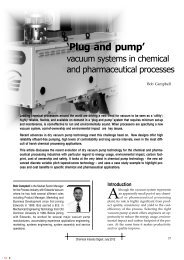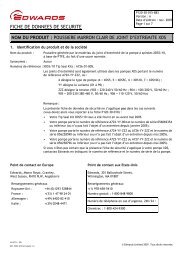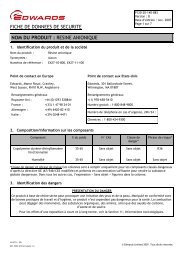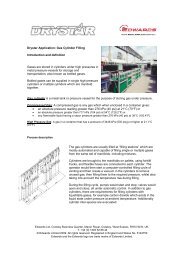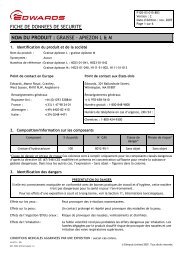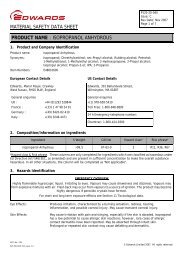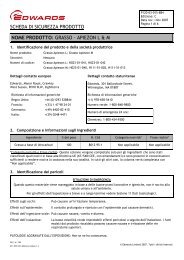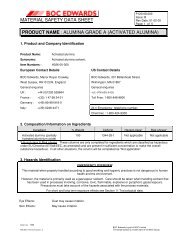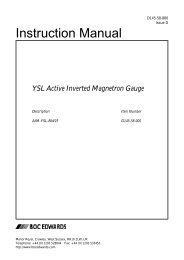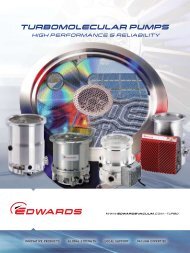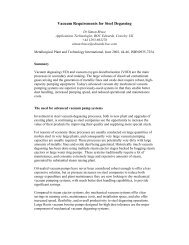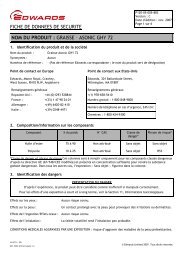- Page 1 and 2:
PRODUCT CATALOGUE2012
- Page 3:
ContentsSmall Wet/Dry PumpsTurbomol
- Page 6 and 7:
Small Pumps and Pumping Systems1Pag
- Page 8 and 9:
Small Pumps and Accessories: Freque
- Page 10 and 11:
1Page6Technical DataNominal rotatio
- Page 12 and 13:
1Page8Technical DataNominal rotatio
- Page 14 and 15:
1Page10Technical DataNominal rotati
- Page 16 and 17:
1Page12Technical DataNominal rotati
- Page 18 and 19:
XDS35i Scroll Vacuum Pump1Page14The
- Page 20:
XDS46i Scroll Vacuum Pump1Page16The
- Page 23 and 24:
Technical DataOrdering InformationP
- Page 25 and 26:
E2M0.7 Two Stage Rotary Vane PumpTh
- Page 27 and 28:
E2M1.5 Two Stage Rotary Vane PumpTh
- Page 29 and 30:
RV3 Two Stage Rotary Vane PumpEdwar
- Page 31 and 32:
RV5 Two Stage Rotary Vane PumpEdwar
- Page 33 and 34:
RV8 Two Stage Rotary Vane PumpEdwar
- Page 35 and 36:
RV12 Two Stage Rotary Vane PumpEdwa
- Page 37 and 38:
E1M18 One Stage, E2M18 Two Stage Ro
- Page 39 and 40:
E2M28 Two Stage Rotary Vane PumpThe
- Page 41 and 42:
RV ATEX Two Stage Rotary Vane PumpA
- Page 43 and 44:
E1M18 One Stage, E2M18 Two Stage AT
- Page 45 and 46:
Electrical DataSmall Pump Accessori
- Page 47 and 48:
Ordering InformationProduct Descrip
- Page 49 and 50:
Vibration IsolatorsYou may need to
- Page 51 and 52:
Performance Curves1. D-LAB 34-100 2
- Page 53 and 54:
Technical DataOrdering InformationP
- Page 55 and 56:
Turbomolecular Pumps2Page51nEXT Tur
- Page 57 and 58:
VentingTo maintain the cleanliness
- Page 59 and 60:
Technical DataInlet flangeDN100ISO-
- Page 61 and 62:
Technical DataInlet flangeDN100ISO-
- Page 63 and 64:
Technical DataInlet flangeDN160ISO-
- Page 65 and 66:
Technical DataOrdering InformationI
- Page 67 and 68:
Technical DataOrdering InformationM
- Page 69 and 70:
Technical DataMax input Power240WMa
- Page 71 and 72:
Technical DataPump / TIC powerEXT75
- Page 73 and 74:
Technical DataOrdering InformationM
- Page 75 and 76:
Vibration IsolatorA vibration isola
- Page 77 and 78:
Technical DataPumping Speed for N 2
- Page 79 and 80:
STP Magnetically Levitated Turbomol
- Page 81 and 82:
STPs and the EnvironmentReducing En
- Page 83 and 84:
Technical DataOrdering InformationI
- Page 85 and 86:
Technical DataOrdering InformationI
- Page 87 and 88:
Technical DataOrdering InformationI
- Page 89 and 90:
Technical DataOrdering InformationI
- Page 91 and 92:
Technical DataOrdering InformationI
- Page 93 and 94:
Technical DataOrdering InformationI
- Page 95 and 96:
Technical DataOrdering InformationI
- Page 97 and 98:
Technical DataOrdering InformationI
- Page 99 and 100:
Technical DataOrdering InformationI
- Page 101 and 102:
Technical DataOrdering InformationI
- Page 103 and 104:
Technical DataOrdering InformationI
- Page 105 and 106:
Technical DataOrdering InformationI
- Page 107 and 108:
Technical DataOrdering InformationI
- Page 109 and 110:
Technical DataOrdering InformationI
- Page 111 and 112:
Technical DataOrdering InformationI
- Page 113 and 114:
Technical DataOrdering InformationI
- Page 115 and 116:
Technical DataInlet flange sizeVF30
- Page 117 and 118:
Technical DataOrdering InformationM
- Page 119 and 120:
Ordering InformationProduct Descrip
- Page 121 and 122:
Vapour Pumps3Page117High Throughput
- Page 123 and 124:
Vapour Pumps for Industrial Applica
- Page 125 and 126:
Technical DataOrdering InformationC
- Page 127 and 128:
Technical DataOrdering InformationC
- Page 129 and 130:
Technical DataOrdering InformationC
- Page 131 and 132:
Technical DataOrdering InformationP
- Page 133 and 134:
Technical DataOrdering InformationP
- Page 135 and 136:
Ordering informationProduct descrip
- Page 137 and 138:
250/2000 Installation3711163P10**5P
- Page 139 and 140:
Notes3Page135Shop online at www.edw
- Page 141 and 142:
Measurement & Control4TIC Instrumen
- Page 143 and 144:
The Active Gauge Concept• Operate
- Page 145 and 146:
Technical DataElectrical DataConnec
- Page 147 and 148:
Technical DataOrdering InformationE
- Page 149 and 150:
Technical DataActive gauge compatib
- Page 151 and 152:
Technical DataMass85 gInternal volu
- Page 153 and 154:
Ordering InformationProduct Descrip
- Page 155 and 156:
Technical DataATC-E Electronics Mod
- Page 157 and 158:
Technical DataFull scale pressure r
- Page 159 and 160:
Technical DataFull scale pressure r
- Page 161 and 162:
Technical DataPressure RangeAIM-X10
- Page 163 and 164:
Technical DataPressure rangeAccurac
- Page 165 and 166:
Ordering InformationProduct Descrip
- Page 167 and 168:
CG16K dial gaugeEdwards CG16K capsu
- Page 169 and 170:
VS16K Adjustable Vacuum SwitchThe V
- Page 171 and 172:
Vacuum ValvesSpeedivalves 169Ball V
- Page 173 and 174:
SpeedivalveEdwards SP Speedivalves
- Page 175 and 176:
IBV series vacuum ball valvesBall v
- Page 177 and 178:
PVMK Manual Operation Right Angle I
- Page 179 and 180:
PVPK Pneumatic Operation Right Angl
- Page 181 and 182:
IPVPK Pneumatic Operation In-Line I
- Page 183 and 184:
PVEK Solenoid Operation Right Angle
- Page 185 and 186:
IPVEK Solenoid Operation In-Line Is
- Page 187 and 188:
LCPVEK Solenoid Operation Isolation
- Page 189 and 190:
LCPVEK Solenoid Operation Isolation
- Page 191 and 192:
BRV Backing/Roughing ValveEdwards b
- Page 193 and 194:
SIPVP Soft-Start Isolation ValvesSo
- Page 195 and 196:
BGV Manual Gate ValvesThe BGV basem
- Page 197 and 198:
BGV Pneumatic Gate ValvesThe BGV ba
- Page 199 and 200:
GV Manual and Pneumatic Gate Valves
- Page 201 and 202:
QSB Quarter Swing Butterfly ValveTh
- Page 203 and 204:
AV5A Air Admittance Valve With Coup
- Page 205 and 206:
LV10K Leak Valve NW10 FlangesThe LV
- Page 207 and 208:
Technical DataValveGV gate valvesPV
- Page 209 and 210:
Fittings and FlangesProduct Summary
- Page 211 and 212:
CF Flange Names There are many desc
- Page 213 and 214:
DimensionsNW Dimensions2.5ØAØBISO
- Page 215 and 216:
NW fittingsSize A B C D E F Orderin
- Page 217 and 218:
Size A B C D E F Ordering NumberNit
- Page 219 and 220:
Size A B C D E F Ordering NumberAEl
- Page 221 and 222:
Size A B C D E F Ordering NumberAFu
- Page 223 and 224:
Size A B C D E F Ordering NumberABA
- Page 225 and 226:
Size A B C D E F Ordering NumberABC
- Page 227 and 228:
ISO fittingsSize A B C D E F Orderi
- Page 229 and 230:
Size A B C D E F Ordering NumberACe
- Page 231 and 232:
Size A B C D E F Ordering NumberBAT
- Page 233 and 234:
Size A B C D E F Ordering NumberABF
- Page 235 and 236:
Size A B C D E F Ordering NumberACD
- Page 237 and 238:
Size A B C D E F Ordering NumberElb
- Page 239 and 240:
Size A B C D E F Ordering NumberDAB
- Page 241 and 242:
Size A B C D E F Ordering NumberAC
- Page 243 and 244:
Oils, Fluids, Sealants and GreasesW
- Page 245 and 246:
Mechanical Pump Oil Selection Chart
- Page 247 and 248:
Vapour Pump FluidsEdwards supplies
- Page 249 and 250:
Greases and WaxesGreases and waxesS
- Page 251 and 252:
Semiconductor PumpsiXL Dry Pumps 24
- Page 253 and 254:
Technical DataProductiXL120Peak spe
- Page 255 and 256:
Technical DataPeak speedUltimate va
- Page 257 and 258:
Technical DataPeak speedUltimate va
- Page 259 and 260:
Technical DataOrdering InformationP
- Page 261 and 262:
Technical DataOrdering InformationP
- Page 263 and 264:
Technical DataPeak speedUltimate va
- Page 265 and 266:
Technical DataPeak speedUltimate va
- Page 267 and 268:
Technical DataOrdering InformationP
- Page 269 and 270:
Technical DataOrdering InformationP
- Page 271 and 272:
Technical DataPerformancePeak speed
- Page 273 and 274:
Technical DataPerformancePeak speed
- Page 275 and 276:
Technical DataPerformancePeak speed
- Page 277 and 278:
Product Selection GuideVacuumPROCES
- Page 279 and 280:
Industrial Pumps and Pumping System
- Page 281 and 282:
EV Oil Sealed Single Stage Rotary V
- Page 283 and 284:
GXS industrial Dry Screw PumpDesign
- Page 285 and 286:
Technical DataOrdering InformationG
- Page 287 and 288:
Technical DataOrdering InformationG
- Page 289 and 290:
Technical DataOrdering InformationG
- Page 291 and 292:
Technical DataOrdering InformationG
- Page 293 and 294:
Technical DataOrdering InformationD
- Page 295 and 296:
Technical DataMass IDX1000 IDX13005
- Page 297 and 298:
ITM High Capacity Inlet Dust Filter
- Page 299 and 300:
Technical DataDisplacement50Hz 42.5
- Page 301 and 302:
Technical DataDisplacement50Hz 80 m
- Page 303 and 304:
Technical DataDisplacement50Hz 178
- Page 305 and 306:
Technical DataDisplacement50Hz 292
- Page 307 and 308:
Vibration IsolatorsYou may need to
- Page 309 and 310:
Ordering Information - All Territor
- Page 311 and 312:
Stokes Microvac Series Oil Sealed R
- Page 313 and 314:
Stokes Microvac Model 412JThe Stoke
- Page 315 and 316:
Stokes Microvac Model 912JThe Stoke
- Page 317 and 318:
Oil Reservoir HeaterEdwards model 2
- Page 319 and 320:
MB/MV Series VerticallyOriented Boo
- Page 321 and 322:
Stokes 612MB Multi-Stage Pumping Sy
- Page 323 and 324:
Stokes 1721 Mechanical Booster Pump
- Page 325 and 326:
Stokes 1722 Mechanical Booster Pump
- Page 327 and 328:
Stokes 1733 Mechanical Booster Pump
- Page 329 and 330:
Stokes 1733HD Mechanical Booster Pu
- Page 331 and 332:
Stokes 1738BP Mechanical Booster Pu
- Page 333 and 334:
Stokes 1738 HCBP Mechanical Booster
- Page 335 and 336:
Stokes 1738HDBP Mechanical Booster
- Page 337 and 338:
Stokes 1739BP Mechanical Booster Pu
- Page 339 and 340:
Stokes 1739HCBP Mechanical Booster
- Page 341 and 342:
Stokes 1739HDBP Mechanical Booster
- Page 343 and 344:
Stokes 1754HC Mechanical Booster Pu
- Page 345 and 346:
EV40 Oil Sealed PumpThe EV rotary v
- Page 347 and 348:
EV100 Oil Sealed PumpThe EV rotary
- Page 349 and 350:
EV200 Rotary vane pumpThe EV rotary
- Page 351 and 352:
EV400 Rotary vane pumpThe EV rotary
- Page 353 and 354:
Accessories for Single Stage Oil Se
- Page 355 and 356:
EH Mechanical Booster PumpsBroad Ap
- Page 357 and 358:
EH250 Mechanical Booster PumpThe EH
- Page 359 and 360:
EH500 Mechanical booster pumpThe EH
- Page 361 and 362:
EH1200 Mechanical booster pumpThe E
- Page 363 and 364:
EH2600 Mechanical booster pumpThe E
- Page 365 and 366:
EH4200 Mechanical booster pumpThe E
- Page 367 and 368:
Mechanical Booster Pump Accessories
- Page 369 and 370:
Stokes 607 Series Mechanical Booste
- Page 371 and 372:
Stokes 615 Series Mechanical Booste
- Page 373 and 374:
Stokes 61B Series By-Pass Mechanica
- Page 375 and 376:
Stokes 622 Series Mechanical Booste
- Page 377 and 378:
HV8000 Mechanical booster pumpThe E
- Page 379 and 380:
HV30000 Mechanical Booster PumpThe
- Page 381 and 382:
Chemical Dry PumpsCXS Chemical dry
- Page 383 and 384:
CXS Chemical Dry Screw PumpDesigned
- Page 385 and 386:
CXS160 chemical dry pumpEdwards pio
- Page 387 and 388:
CXS250 chemical dry pumpEdwards pio
- Page 389 and 390:
CDX1000 Dry Vacuum PumpEdwards CDX1
- Page 391 and 392:
EDP80 - Dry Chemical PumpsEDP pumps
- Page 393 and 394:
EDP160 - Dry Chemical PumpsEDP pump
- Page 395 and 396:
EDP250 - Dry Chemical PumpsEDP pump
- Page 397 and 398:
EDP400 - Dry Chemical PumpsEDP pump
- Page 399 and 400:
Liquid Ring PumpsHR Series Liquid R
- Page 401 and 402:
ApplicationsSome of the more common
- Page 403 and 404:
Liquid Ring Pump Applications in Po
- Page 405 and 406:
Features & Benefits• Two stage li
- Page 407 and 408:
Exhaust Gas Treatment ApplicationsT
- Page 409 and 410:
EHR2390 Liquid Ring PumpWithin Edwa
- Page 411 and 412:
SHR2750 Liquid Ring PumpWithin Edwa
- Page 413 and 414:
SHR21200 Liquid Ring PumpWithin Edw
- Page 415 and 416: SHR22500 Liquid Ring PumpWithin Edw
- Page 417 and 418: LR1A300 Liquid Ring PumpEdwards off
- Page 419 and 420: LR1A500 Liquid Ring PumpEdwards off
- Page 421 and 422: LR1A800 Liquid Ring PumpEdwards off
- Page 423 and 424: LR1A1300 Liquid Ring PumpEdwards of
- Page 425 and 426: LR1A2500 Liquid Ring PumpEdwards of
- Page 427 and 428: LR1A5000 Liquid Ring PumpEdwards of
- Page 429 and 430: LR1A6500 Liquid Ring PumpEdwards of
- Page 431 and 432: LR1A12000 Liquid Ring PumpEdwards o
- Page 433 and 434: LR1A16000 Liquid Ring PumpEdwards o
- Page 435 and 436: LR1A23000 Liquid Ring PumpEdwards o
- Page 437 and 438: LR1B3500 Liquid Ring PumpEdwards of
- Page 439 and 440: LR1B6000 Liquid Ring PumpEdwards of
- Page 441 and 442: LR1B8000 Liquid Ring PumpEdwards of
- Page 443 and 444: LR1B11000 Liquid Ring PumpEdwards o
- Page 445 and 446: LR1B13000 Liquid Ring PumpEdwards o
- Page 447 and 448: LR1B15000 Liquid Ring PumpEdwards o
- Page 449 and 450: LR1B21000 Liquid Ring PumpEdwards o
- Page 451 and 452: LR1B30000 Liquid Ring PumpEdwards o
- Page 453 and 454: Shelf Dryers11Page449Shop online at
- Page 455 and 456: Data Summary Stokes Vacuum Shelf Dr
- Page 457 and 458: Process Vacuum12Page453Shop online
- Page 459 and 460: Deaeration EquipmentMultistage Ejec
- Page 461 and 462: Boiler Feedwater and Process Water
- Page 463 and 464: ServiceGuide to Pump Selection and
- Page 465: Certified ProductsEdwards Certified
- Page 469 and 470: Effect of the Pipe Between the Seco
- Page 471 and 472: Material Safety Data SheetsThe foll
- Page 473 and 474: Shop online at www.edwardsvacuum.co
- Page 475 and 476: Shop online at www.edwardsvacuum.co
- Page 477 and 478: Shop online at www.edwardsvacuum.co
- Page 479 and 480: Shop online at www.edwardsvacuum.co
- Page 481 and 482: Shop online at www.edwardsvacuum.co
- Page 483 and 484: RoHS ComplianceThe EU RoHS (Restric



